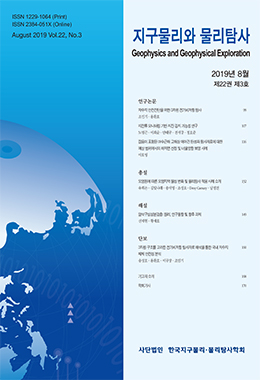고품질의 고해상 해저 탄성파 탐사자료를 얻기 위해서는 해상의 파도가 매우 낮은 환경에서 탐사가 이루어져야 하지만, 약간의 파도가 있는 상태에서 탐사를 수행하는 경우가 많으며 이로 인하여 자료의 품질이 저하된다. 이러한 경우에는 자료처리 과정에서 해저면 신호의 정확한 위치를 파악하여 자동적으로 파도 또는 너울의 영향을 제거함으로써 탄성파 자료의 품질을 향상시킬 수 있다. 그러나 파도의 영향으로 인하여 잡음이 포함되거나 해저면 신호가 약해진 자료에서는 해저면 위치 선정에 오류가 발생하기 쉽다. 이 연구에서는 해저면의 위치를 예상하여 좁은 선정 범위를 설정한 후 이 범위 내에서 해저면의 위치를 선정함으로써 이와 같은 오류를 감소시키는 방법을 사용하였다. 해저면 예상 위치는 다중채널 자료에서 각 채널별로 이전에 선정한 해저면의 위치들을 이용하여 산출하였다. 또한 채널별로 산출한 해저면 예상 위치를 샷모음 내에서 다른 해저면 예상 위치와 비교하여 검증하였다. 이와 같은 방법을 잡음이 포함된 여수근해 8채널 고해상 에어건 탐사자료에 적용한 결과, 해저면 신호 이전의 잡음이나 이후의 강한 반사 신호를 선정하는 오류가 현저하게 감소되었으며, 약 2.5 m의 너울영향을 보정한 고품질의 탄성파 단면도를 제작할 수 있었다.
In order to obtain high-quality high-resolution marine seismic data, the survey needs to be carried out at very low-sea condition. However, the survey is often performed with a slight wave, which degrades the quality of data. In this case, it is possible to improve the quality of seismic data by detecting the exact location of the sea bottom signal and eliminating the influence of waves or swells automatically during data processing. However, if noise is included or the sea bottom signal is weakened due to sea waves, sea bottom detection errors are likely to occur. In this study, we applied a method reducing such errors by estimating the sea bottom location, setting a narrow detection range and detecting the sea bottom location within this range. The expected location of the sea bottom was calculated using previously detected sea bottom locations for each channel of multi-channel data. The expected location calculated in each channel is also compared and verified with expected locations of other channels in a shot gather. As a result of applying this method to the noisy 8-channel high-resolution air-gun seismic data acquired off Yeosu, the errors in selecting the strong noise before sea bottom or the strong subsurface reflected signal after the sea bottom signal are remarkably reduced and it is possible to produce the high-quality seismic section with the correction of ~ 2.5 m swell effect.


